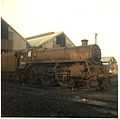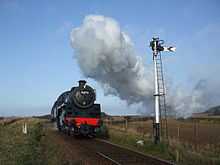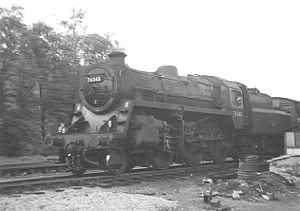BR Standard Class 4 2-6-0
| BR Standard Class 4 2-6-0 | |
|---|---|
|
76040 at Water Orton in 1965 | |
| Type and origin | |
| Power type | Steam |
| Designer | R. A. Riddles |
| Builder |
BR Horwich (45) Doncaster (25) Derby Works (45) |
| Build date | December 1952 – November 1957 |
| Total produced | 115 |
| Specifications | |
| Configuration | 2-6-0 |
| UIC classification | 1′C h2 |
| Gauge | 4 ft 8 1⁄2 in (1,435 mm) |
| Leading wheel diameter | 3 ft 0 in (0.914 m) |
| Driver diameter | 5 ft 3 in (1.600 m) |
| Length | 60 ft 0 in (18.29 m) |
| Width | 8 ft 9 1⁄2 in (2.68 m) |
| Height | 13 ft 0 in (3.96 m) |
| Axle load |
Loco: 16.95 long tons (17.22 t) BR1B tender: 17.10 long tons (17.37 t) |
| Weight on drivers | 50.45 long tons (51.26 t) |
| Locomotive weight | 59.75 long tons (60.71 t) |
| Tender weight |
BR1B: 49.15 long tons (49.94 t) BR2/BR2A: 42.15 long tons (42.83 t) |
| Tender type | BR1B (17), BR2 (45), BR2A (53) |
| Fuel type | Coal |
| Fuel capacity |
BR1B: 7.00 long tons (7.11 t) BR2/BR2A: 6.00 long tons (6.10 t) |
| Water capacity |
BR1B: 4,250 imp gal (19,300 l; 5,100 US gal) BR2/BR2A: 3,500 imp gal (16,000 l; 4,200 US gal) |
| Boiler | BR7 |
| Boiler pressure | 225 psi (1.55 MPa) |
| Firegrate area | 23 sq ft (2.1 m2) |
| Heating surface: – Tubes and flues | 1,075 sq ft (99.9 m2) |
| – Firebox | 131 sq ft (12.2 m2) |
| Superheater area | 247 sq ft (22.9 m2) |
| Cylinders | Two, outside |
| Cylinder size | 17.5 in × 26 in (444 mm × 660 mm) |
| Performance figures | |
| Tractive effort | 24,170 lbf (107.5 kN) |
| Factor of adhesion | 4.68 |
| Career | |
| Operator(s) | British Railways |
| Power class | 4MT |
| Number(s) | 76000–76114 |
| Axle load class | Route Availability 4 |
| Withdrawn | May 1964 – December 1967 |
| Disposition | Four preserved, remainder scrapped |
The BR Standard Class 4 2-6-0 is a class of steam locomotive designed by Robert Riddles for British Railways (BR). 115 locomotives were built to this standard.
Design and construction
The class was designed at the ex-LNER works at Doncaster which was also responsible for building 25 of the 115-strong class. The remaining 90 were split between Horwich and Derby Works.
The last in the series, No.76114, was also the final steam engine to be constructed at the 'Plant' (as Doncaster works was known). The Standard Four Mogul was essentially a standardised version of the LMS Ivatt Class 4, and was primarily intended for freight use.
Although a BR Standard, the 4 2-6-0 class did not have the same design of wheels as the Swindon-built 82XXX and 77XXX Class 3 engines which also had 5-foot-3-inch (1.600 m) driving wheels, yet all three locomotive classes share the same cylinder casting.
The cylinder covers of engines built early in the programme of construction were fitted with "screw-in" type pressure relief valves. From September 1955 revised cylinder covers were introduced for renewals incorporating "bolt-on" type pressure relief valves.[1]
Operation
With its 5-foot-3-inch (1.600 m) diameter driving wheels this sixth of the BR standard designs was clearly biased towards freight working. An axle-loading of only 16 tons 15 cwt meant its route availability was virtually unrestricted. Batches were allocated to every BR region except the Western.
Scottish Region
Thirty-five units were allocated to the Scottish Region, used on the Waverley Line between Carlisle and Hawick. Others appeared on the 'Port Road' from Dumfries to Stranraer. The Scottish examples were mainly concentrated in Ayrshire and around Glasgow, and at one time Corkerhill depot was home to ten of the class. Five units were based in Aberdeen and three went to Thornton in Fife.
Southern Region
The Southern moguls (originally 37) were also concentrated in one area around Eastleigh, Southampton and Bournemouth. They were used between Portsmouth, Salisbury and Cardiff, Reading to Redhill, Brighton to Bournemouth and over the Swanage branch. Their most celebrated duty was the London Waterloo to Lymington boat train. However this had nothing to do with the engines' capabilities; it was simply that among tender engines only a 2-6-0 or 4-4-0 could fit on the turntable at Brockenhurst. In the last few years of steam operation on the 'Southern' a few examples were allocated to Guildford shed before moving on to Feltham shed in S.W. London.
All 17 locomotives equipped with the BR1B high-sided tender were allocated to the Southern Region. The BR1B tender had a higher axle load than the locomotives.
-

76066 with BR1B tender at Eastleigh shed in February 1967
North Eastern Region
At first the North Eastern Region scattered its 13-strong allocation far and wide: Darlington, Gateshead, Hull, Sunderland and York. Later all were concentrated at either Kirkby Stephen or West Auckland to work over the Stainmore route whose viaducts had severe weight restrictions. Like their small cousins the 2MT 2-6-0 class the Moguls were ideal for working the line. They worked coal trains as well as passenger services and were a regular choice for excursions from Tyneside to the Lancashire coast resorts.
London Midland Region
Apart from a pair allocated to Leicester, most of the London Midland Region's batch of 15 spent their working lives in the Liverpool, Manchester and Preston areas.
Eastern Region

The Eastern Region divided its 15 between two London depots. Five went to Stratford on the ex-Great Eastern section, and the remainder to the one-time Great Central depot at Neasden. Made redundant by dieselisation the Stratford engines were transferred to the Southern and arrived at Brighton. The Neasden engines also in due course departed the capital, in this case for Chester and ex-Cambrian Railways territory. One Eastern locomotive was 76034 which was fitted with a tablet catcher for running over the M&GN lines in East Anglia. 76079 has visited the North Norfolk Railway in preservation times.
Accidents and incidents
- On 23 September 1954, locomotive No. 76014 was hauling a freight train that overran signals and was derailed by trap points at Whitchurch Town station, Hampshire.[2]
- In December 1957, locomotive No. 76016 was hauling a freight train that overran signals and was derailed by trap points at Woodhay station, Hampshire.[2]
- On 12 February 1960, locomotive No. 76026 was hauling a freight train that overran signals and was derailed by trap points at Whitchurch Town station.[2]
Preservation
Four examples have been saved:
- 76017 - Is on the Watercress Line and is currently under overhaul.
- 76077 - Is being restored on the Gloucestershire Warwickshire Railway.
- 76079 - Formerly owned by Ian Riley, now based at the NYMR. The locomotive has recently returned to traffic following an overhaul, boiler ticket expires 2024.
- 76084 - Owned by 76084 Locomotive Company Limited. Currently on North Norfolk Railway for 2013 and 2014 seasons. Planned to go mainline by Mid 2015 - support coach (BSK 35457) already refurbished for the purpose.
Models
The erstwhile Kitmaster company produced an unpowered polystyrene injection moulded model kit for 00 gauge. In late 1962, the Kitmaster brand was sold by its parent company (Rosebud Dolls) to Airfix, who transferred the moulding tools to their own factory; they re-introduced some of the former Kitmaster range, including this locomotive. In time, the moulding tools passed on to Dapol who have also produced the model kit.[3]
Bachmann produces a ready-to-run model in both 00 and N gauge.[4]
Sound
- 76079 Between Egton and Grosmont
- 76079 departing from Grosmont
Footnotes
- ↑ Rear cylinder cover SL/SW/35 being superseded by SL/SW/666 and front cylinder cover SL/SW/85 being superseded by SL/SW/667 for renewals from September 1955
- ↑ 2.0 2.1 2.2 Bishop, Bill (1984). Off the Rails. Southampton: Kingfisher. pp. 55–65. ISBN 0 946184 06 2.
- ↑ Knight, Stephen (1999). Let's Stick Together: An Appreciation of Kitmaster and Airfix Railway Kits. Clopthill: Irwell Press. ISBN 1-871608-90-2.
- ↑ http://www.bachmann.co.uk/image_box.php?image=images1/branchline/32-952A.jpg&cat_no=32-952A&info=33&width=650&height=260
Bibliography
- A Detailed History of BR Standard Steam Locomotives, - Vol 2 - The 4-6-0 and 2-6-0 Classes. RCTS ISBN 0-901115-93-2
- Bradley, Rodger P. (1984). The Standard Steam Locomotives of British Railways. David & Charles Publishers plc.
External links
| Wikimedia Commons has media related to BR Standard Class 4 2-6-0. |
| ||||||||||||||
